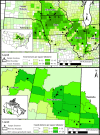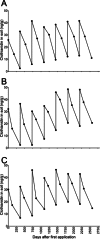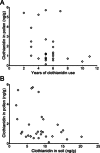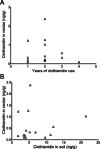Clothianidin in agricultural soils and uptake into corn pollen and canola nectar after multiyear seed treatment applications
- PMID: 26467536
- PMCID: PMC4736462
- DOI: 10.1002/etc.3281
Clothianidin in agricultural soils and uptake into corn pollen and canola nectar after multiyear seed treatment applications
Abstract
Limited data are available on the fate of clothianidin under realistic agricultural production conditions. The present study is the first large-scale assessment of clothianidin residues in soil and bee-relevant matrices from corn and canola fields after multiple years of seed-treatment use. The average soil concentration from 50 Midwest US corn fields with 2 yr to 11 yr of planting clothianidin-treated seeds was 7.0 ng/g, similar to predicted concentrations from a single planting of Poncho 250-treated corn seeds (6.3 ng/g). The water-extractable (i.e., plant-bioavailable) clothianidin residues in soil were only 10% of total residues. Clothianidin concentrations in soil reached a plateau concentration (amount applied equals amount dissipated) in fields with 4 or more application years. Concentrations in corn pollen from these fields were low (mean: 1.8 ng/g) with no correlation to total years of use or soil concentrations. For canola, soil concentrations from 27 Canadian fields with 2 yr to 4 yr of seed treatment use (mean = 5.7 ng/g) were not correlated with use history, and plant bioavailability was 6% of clothianidin soil residues. Average canola nectar concentrations were 0.6 ng/g and not correlated to use history or soil concentrations. Under typical cropping practices, therefore, clothianidin residues are not accumulating significantly in soil, plant bioavailability of residues in soil is limited, and exposure to pollinators will not increase over time in fields receiving multiple applications of clothianidin.
Keywords: Adsorption; Bioavailability; Clothianidin; Fate and transport; Neonicotinoid; Pollen.
© 2015 The Authors. Published by Wiley Periodicals, Inc. on behalf of SETAC.
Figures






Similar articles
-
Potential exposure of pollinators to neonicotinoid insecticides from the use of insecticide seed treatments in the mid-southern United States.Environ Sci Technol. 2014 Aug 19;48(16):9762-9. doi: 10.1021/es501657w. Epub 2014 Jul 23. Environ Sci Technol. 2014. PMID: 25010122
-
Large-scale monitoring of effects of clothianidin-dressed oilseed rape seeds on pollinating insects in northern Germany: residues of clothianidin in pollen, nectar and honey.Ecotoxicology. 2016 Nov;25(9):1691-1701. doi: 10.1007/s10646-016-1723-x. Epub 2016 Sep 20. Ecotoxicology. 2016. PMID: 27650369 Free PMC article.
-
Field-scale examination of neonicotinoid insecticide persistence in soil as a result of seed treatment use in commercial maize (corn) fields in southwestern Ontario.Environ Toxicol Chem. 2016 Feb;35(2):295-302. doi: 10.1002/etc.3231. Epub 2015 Dec 15. Environ Toxicol Chem. 2016. PMID: 26332416
-
A review of the factors that influence pesticide residues in pollen and nectar: Future research requirements for optimising the estimation of pollinator exposure.Environ Pollut. 2019 Jun;249:236-247. doi: 10.1016/j.envpol.2019.03.025. Epub 2019 Mar 12. Environ Pollut. 2019. PMID: 30893636 Review.
-
Plant protection product residues in plant pollen and nectar: A review of current knowledge.Environ Res. 2020 Oct;189:109873. doi: 10.1016/j.envres.2020.109873. Epub 2020 Jul 9. Environ Res. 2020. PMID: 32795671
Cited by
-
Impacts of chronic sublethal exposure to clothianidin on winter honeybees.Ecotoxicology. 2016 Jul;25(5):1000-10. doi: 10.1007/s10646-016-1657-3. Epub 2016 Apr 18. Ecotoxicology. 2016. PMID: 27090425
-
A critical review on the potential impacts of neonicotinoid insecticide use: current knowledge of environmental fate, toxicity, and implications for human health.Environ Sci Process Impacts. 2020 Jun 24;22(6):1315-1346. doi: 10.1039/c9em00586b. Environ Sci Process Impacts. 2020. PMID: 32267911 Free PMC article. Review.
-
Is there a risk to honeybees from use of thiamethoxam as a sugar beet seed treatment?Integr Environ Assess Manag. 2022 May;18(3):709-721. doi: 10.1002/ieam.4498. Epub 2021 Aug 18. Integr Environ Assess Manag. 2022. PMID: 34292667 Free PMC article.
-
Impact of pesticide/fertilizer mixtures on the rhizosphere microbial community of field-grown sugarcane.3 Biotech. 2021 May;11(5):210. doi: 10.1007/s13205-021-02770-3. Epub 2021 Apr 10. 3 Biotech. 2021. PMID: 33927998 Free PMC article.
-
Sub-Lethal Doses of Clothianidin Inhibit the Conditioning and Biosensory Abilities of the Western Honeybee Apis mellifera.Insects. 2019 Oct 11;10(10):340. doi: 10.3390/insects10100340. Insects. 2019. PMID: 31614672 Free PMC article.
References
-
- Hurley T, Mitchell PD. 2014. The value of neonicotinoids in North American agriculture: Value of insect pest management to U.S. and Canadian corn, soybean and canola farmers. AgInformatics, St. Paul, MN. [Cited 2015 February]. Available from: http://www.growing matters.org
-
- Rexrode M, Barrett M, Ellis J, Gabe P, Vaughan A, Felkel J, Melendez J. 2003. EFED risk assessment for the seed treatment of clothianidin 600FS on corn and canola. US Environmental Protection Agency, Washington, DC.
-
- Goulson D. 2013. An overview of the environmental risks posed by neonicotinoid insecticides. J Appl Ecol 50:977–987.
-
- Jones A, Harrington P, Turnbull G. 2014. Neonicotinoid concentrations in arable soils after seed treatment applications in preceding years. Pest Manag Sci 70:1780–1784. - PubMed
-
- US Environmental Protection Agency. 2012. Final test guidelines; OCSPP 850 series; Notice of availability. Fed Reg 77:38282–38285.
MeSH terms
Substances
LinkOut - more resources
Full Text Sources
Other Literature Sources

